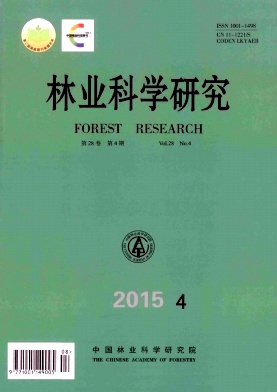|
[1]
|
Haack R A, Hérard F, Sun J, et al. Managing invasive populations of Asian longhorned beetle and citrus longhorned beetle: a worldwide perspective[J]. Annual Review of Entomology, 2010, 55: 521-546. |
|
[2]
|
李建庆, 杨忠岐, 张雅林, 等. 利用花绒寄甲防治杨树云斑天牛的研究[J]. 林业科学, 2009, 45(9): 94-100.
|
|
[3]
|
魏建荣, 牛艳玲. 西安城区环境中释放花绒寄甲成虫对光肩星天牛的生物防治效果评价[J]. 昆虫学报, 2012, 54(12): 1399-1405.
|
|
[4]
|
卢希平, 杨忠岐, 孙绪艮, 等. 利用花绒寄甲防治锈色粒肩天牛[J]. 林业科学, 2012, 47(10): 116-121.
|
|
[5]
|
杨忠岐, 李建庆, 梅增霞, 等. 释放花绒寄甲防治危害白蜡的云斑天牛[J]. 林业科学, 2012, 47(12): 78-84.
|
|
[6]
|
Yang Z Q, Wang X Y, Zhang Y N. Recent advances in biological control of important native and invasive forest pests in China[J]. Biological Control, 2014, 68: 117-128. |
|
[7]
|
张彦龙, 杨忠岐, 张翌楠, 等. 利用花绒寄甲防治越冬后松褐天牛试验[J]. 林业科学, 2014, 50(3): 92-98.
|
|
[8]
|
周嘉熹, 鲁新政, 逯玉中. 引进花绒坚甲防治黄斑星天牛试验报告[J]. 昆虫知识, 1985, 22(2): 84-86.
|
|
[9]
|
高 悦, 解春霞, 刘云鹏, 等. 花绒寄甲对柳树光肩星天牛的防治效果及寄生能力[J]. 西南林业大学学报, 2013, 33(5): 104-106.
|
|
[10]
|
李孟楼, 李有忠, 雷 琼, 等. 释放花绒寄甲卵对光肩星天牛幼虫的防治效果[J]. 林业科学, 2009, 45(4): 78-82.
|
|
[11]
|
李孟楼, 王培新, 马 峰, 等. 花绒坚甲对光肩星天牛的寄生效果研究[J]. 西北农林科技大学学报: 自然科学版, 2007, 35(6): 152-156.
|
|
[12]
|
牛艳玲, 郭 杰, 蒋恒涛, 等. 人工释放花绒寄甲对光肩星天牛的控制效果[J]. 陕西林业科技, 2013, (6): 64-66.
|
|
[13]
|
岳朝阳, 张新平, 张静文, 等. 焉耆盆地林地释放花绒寄甲防治光肩星天牛效果初探[J]. 新疆农业科学, 2013, 50(11): 2085-2091.
|
|
[14]
|
魏建荣, 王素英, 牛艳玲, 等. 花绒寄甲耐寒性研究[J]. 中国森林病虫, 2010, 29(5): 19-20.
|
|
[15]
|
张海剑, 石 洁, 王振营, 等. 二点委夜蛾越冬虫态及其在越冬场所的空间分布调查初报[J]. 植物保护, 2012, 38(3): 146-150.
|
|
[16]
|
黄维正, 李东成. 枣飞象越冬幼虫空间分布格局的研究[J]. 昆虫知识, 1993, 30(6): 348-350.
|
|
[17]
|
许佳林, 王建军. 红脂大小蠹越冬场所及成虫出土观察[J].山西林业科技, 2002, (4): 26-28.
|
|
[18]
|
秦锡祥,高瑞桐. 花绒坚甲生物学特性及其应用研究[J]. 昆虫知识, 1998, 25(2): 109-112.
|
|
[19]
|
王希蒙, 任国栋, 马 峰. 花绒穴甲的分类地位及应用前景[J]. 西北农业学报, 1996, 5(2): 75-78.
|
|
[20]
|
Danks H V. Extreme individuals in natural populations[J]. Bulletin of the Entomological Society of America, 1983, 29(1): 41-48. |
|
[21]
|
Leather S R, Walters K F A, Bale J S. The ecology of insect overwintering[M]. Cambridge: Cambridge University Press, 1995. |
|
[22]
|
Block W, Baust J G, Franks F, et al. Cold tolerance of insects and other arthropods[J]. Philosophical Transactions of the Royal Society of London. B, Biological Sciences, 1990, 326(1237): 613-633. |
|
[23]
|
Lee R E, Chen C, Denlinger D L. A rapid cold-hardening process in insects[J].Science, 1987, 238(4832): 1415-1417. |
|
[24]
|
Czajka M C, Lee R E. A rapid cold-hardening response protecting against cold shock injury in Drosophila melanogaster[J]. Journal of Experimental Biology, 1990, 148(1): 245-254. |
|
[25]
|
陈 豪, 梁革梅, 邹朗云, 等. 昆虫抗寒性的研究进展[J]. 植物保护, 2010, 36(2): 18-24.
|
|
[26]
|
Baust J G, Rojas R R. Review—insect cold hardiness: facts and fancy[J]. Journal of Insect Physiology, 1985, 31(10): 755-759. |
|
[27]
|
冯从经, 吕文静, 董秋安, 等. 低温处理对亚洲玉米螟幼虫抗寒性的诱导效应[J]. 昆虫学报, 2007, 50(1): 1-6.
|
|
[28]
|
赵 静, 陈珍珍, 曲建军, 等. 异色瓢虫成虫冷驯化反应及体内几种酶活力的相关变化[J]. 昆虫学报, 2010, 53(2): 147-153.
|
|
[29]
|
宋修超, 崔宁宁, 郑方强, 等. 变温贮藏僵蚜对烟蚜茧蜂耐寒能力的影响[J]. 应用生态学报, 2012, 23(9): 2515-2520.
|
|
[30]
|
Wei J R, Yang Z Q, Poland T M, et al. Parasitism and olfactory responses of Dastarcus helophoroides (Coleoptera: Bothrideridae) to different Cerambycid hosts[J]. BioControl, 2009, 54(6): 733-742. |





 DownLoad:
DownLoad: